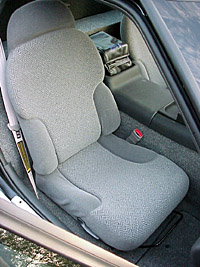|
GMATV direction and future
 Rick Ostrov introduced Ken Stewart, the Brand Manager for
General Motors Advanced Technology Vehicles (GMATV). Ken has
worked at GM for more than 20 years. He was trained as an engineer
and his experience includes power train, ride/handling,
manufacturing, product planning and marketing, and field sales.
Rick Ostrov introduced Ken Stewart, the Brand Manager for
General Motors Advanced Technology Vehicles (GMATV). Ken has
worked at GM for more than 20 years. He was trained as an engineer
and his experience includes power train, ride/handling,
manufacturing, product planning and marketing, and field sales.
Ken started off with some announcements:
- the wait is over, Gen 2 EV1 will start being delivered by
mid November, with test drives beginning this week.
Gen 1 upgrades will occur in the mid-November to December
timeframe. Extensions will be provided for those unable to obtain
Gen 2 cars before their lease is up.
- for existing lease holders, mileage over 30K miles will not be charged
nor will maintenance beyond the 36K warranty coverage.
- the Gen 2 lease will cover 36K miles, and they will be strict
about this. The over mileage charge will be $0.50/mile for NiMH
and $0.35/mile for advanced lead acid. This doesn't begin to
recoup GMs losses, they just need to draw the line clearly this
time. The re-lease of 1997 EV1s will also be $0.35/mile.
- EV1 TV cameos will include
- Everybody Loves Raymond, 11/22
- Friends, 1/6
- Richard Simmons (date unknown)
|
|

Gen 2 EV1 seats with a new fabric will begin
appearing in vehicles delivered later in the year.
|
Ken then fielded some questions from the floor:
- Gen 2 production: about 500 units were manufactured in the first
run, they are taking a wait-and-see attitude before building more.
The Lansing facility has not been shut down and the people are
still around to build more if the demand is there.
- Advertising: after visiting EV1 Clubs in Arizona, Southern
California, and Northern California, his next stop is Hal Riney
Monday morning. He said he won't slam the current ads, which were
intended to launch the category and "did it reasonably well."
However he sees a need to bring it out of the clouds and make it
more reachable, emphasizing the fun aspect of the car. The ads
will also start mentioning where to get the car.
- Market area expansion (given that NiMH prefers colder climates):
wouldn't commit to anything, but said he sees potential in the
Southeast (eg Atlanta) and Northeast (given their rumblings for
mandates similar to California)
- Service (some owners have had bad experiences with delivery and
service, more training is needed at all levels): he will look into
this
- Fast charging: work has been done, although it is the size of a
very large refrigerator
- Gen 3 (must have a pure electric option): GMATV works on all
advanced technologies, including compressed natural gas, parallel
hybrids, series hybrids, and fuel cell. The audience expressed its
dislike of parallel hybrids like the Honda and Toyota offerings,
which are basically high mileage gasoline cars.
He then beat a hasty retreat to the overhead projector:
- Triax
- modular architecture
- 3 propulsion options: pure electric (ZEV), hybrid electric
(ULEV), and ICE (LEV)
- modular seating
- first unveiled at the Tokyo auto show, the first time GM has
ever announced a new model in Japan
- Partnerships with Isuzu and Suzuki
- parallel hybrids
- bus running in New York
- employs a chevron battery configuration with air cooling
- Precept
- midsize 5-passenger parallel hybrid car
- 0.16 coefficient of drag (lower than EV1)
- 3 cylinder diesel engine, 80 mpg
- cameras instead of rear view mirrors
- air intakes at rear sides of the car, pumped out the back
- unveiled January at the Detroit North American International
Auto Show
- inductive charging
- continue pushing MagneCharge as a world standard
- wants to declare victory over conductive charging
- market expansion study
- Southeast market potential, exploration with utility companies
- Opel Zafira fuel cell vehicle
- December 5th celebration
- details will be forthcoming
Ken gamely gave his personal vision (not GM's official position)
for the future:
- the next generation (eg his sons) will have a much greater
level of environmental consciousness
- in 5 years
- hybrid vehicles at or just below critical mass,
similar for low emission and alternative fuel vehicles
- more legislation requiring ULEVs and ZEVs
- multiple usage electric vehicles, eg swiping a card to rent
a vehicle in a retirement community
- in 10 years
- fuel cell vehicles and hybrid vehicles
- electric vehicles for specialty purposes (commuting, sports
cars)
|


